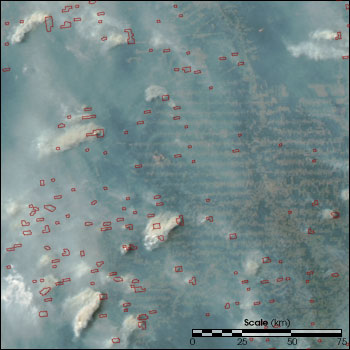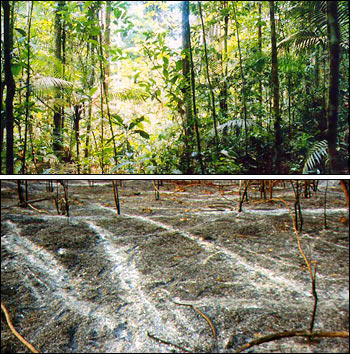

 | |||
Before widespread human settlement began to encroach on the borders of South America’s Amazon forests, there was no such thing as an Amazon fire season. Now, fire may pose the biggest threat to the survival of the Amazon ecosystem. |
| ||
 |
|||
Slash-and-burn agriculture converts forest to farm land, but that obvious destruction is only the beginning. Intentional fires get out of control and burn through the understory of nearby forests, killing, but not completely burning small trees, vines and shrubs. The dead and dying trees collapse, spilling firewood and kindling to the ground and ripping a great tear in the tent of the forest overhead. Logging has a similar effect. The intense tropical sun, previously deflected by the green canopy, heats the forest floor, pushing fire danger even higher. Smoke hangs over the forest and suppresses rainfall. In this damaged, fragmented landscape, the onset of the natural dry season becomes ominous. The El Niño-driven droughts that typically arrive a couple of times per decade become devastating. |
A fire sweeps through a portion of the Amazon Rainforest, reducing the vegetation to ash. Once rarely touched by fire, the portions of the Amazon near areas of human development are becoming increasingly susceptible to damaging fires. (Photograph copyright Woods Hole Research Center) | ||

That is the troubling picture emerging from research by ecologist Daniel Nepstad of the Woods Hole Research Center in Massachusetts and his colleagues in Brazil and the United States, who have been working to identify both the causes and the effects of Amazon fires. Recently, Nepstad has been a part of the Large-scale Biosphere-Atmosphere Experiment in Amazonia. According to Nepstad, the first accidental burn that steals into the forest is the beginning of a long, downward spiral that compromises forest health over an area equal to or greater than the amount that is deforested outright each year. As road-building, slash-and-burn deforestation, and agricultural fires continue to spread across Amazonia, the number of points of possible ignition continues to grow. The Arrival of FireWhen we think of the Amazon, most of us imagine a vast, dripping jungle where an explosion of plants, vines, and trees rise up out of rich, fertile earth. But the Amazon harbors more than a few surprises, one of which is that large portions of the Amazon experience months of seasonal drought every year. In terms of annual rainfall, says Nepstad, “The east and southeast are right on the edge of what it takes to be a forest, and this has been a paradox for some time: How can this portion of the Amazon continue to be lush and evergreen despite the fact that for 4 to 5 months it is not getting much—if any—rain? The answer, we have found, is that trees can tap soil moisture down as far as 20 meters.” |
During the height of the dry season, fires are widespread along the margin of the Amazon. Fingers of cleared land typically form a “herringbone” pattern as they extend from roads (right side of image). This image from the Moderate Resolution Imaging Spectroradiometer was acquired on the afternoon of August 31, 2003. Red outlines trace the pixels in which fires were burning when the image was taken. The smoke from these fires is so thick it hides the surface in places. [View the full-size image (3.5 MB JPEG) for a sense of the widespread scale of burning.] (Image courtesy MODIS Land Rapid Response Team at NASA GSFC) | ||
 |

Historically, even during drought years, there were few, if any, natural fire triggers, since most lightning in the region is accompanied by rain. Scientists think the fire return frequency at any given location in the undisturbed Amazon was on the order of hundreds, possibly even thousands of years. Other than the protection of the dark, humid forest itself, rainforest trees and plants have few defenses or adaptations to fire, and why should they? Until the arrival of fire-wielding humans, the forest had few incentives to evolve them. These days, human impacts in the Amazon are making it more difficult for the forests to endure dry times. Part of the problem is another of the Amazon’s surprises: the soil is infertile. Most of the richness and productivity we associate with the Amazon is bound up in the living organisms in the ecosystem. Layer upon layer of plants, animals, fungi, and bacteria that are spread throughout the forest endlessly recycle the ecosystem’s nutrients. The infertile soil is not well suited to farming, and when the forest is cleared to make way for farms, farmers face the dilemma of how to enrich the soil. In a part of the country where millions of people earn less than $100 per month, expensive soil additives and fertilizer aren’t options. Instead, farmers clear cut the forest and set it on fire in order to turn the nutrients locked up in the forest biomass into a soil-fertilizing ash. |
‘Wet’ and ‘Dry’ characterize the seasons in the Amazon. From January through April, the Amazon basin gets about 10 mm (0.4 inches) of rain a day—300 mm (1 foot) a month! In June, July, and August the region averages 2 mm (0.08 inches) a day. In contrast, temperate regions (like Washington, D. C.) typically get 50-75 mm (2-3 inches) a month, year round. During the 1997-98 El Niño, rainfall in the Amazon was more than 20 percent below normal. (Graph by Robert Simmon, based on data from the Global Precipitation Climatology Project) | |

This slash-and-burn method of agriculture is never more than a short-term solution. Typically within a few years, the initial influx of nutrients from the burned forest is used up.“I think people are very similar whether they are in Texas or Pará, Brazil,” says Nepstad. People are looking to maximize the profit of their land in the short term; they don’t look too far down the line. If you’re poverty stricken, your viewpoint is even shorter.” When the soil fails, farmers move on to a new patch of forest. The old patch may be abandoned or turned into cattle pasture, which must be re-burned frequently to encourage grasses rather than trees or shrubs. The data used in this study are available in one or more of NASA's Earth Science Data Centers. |
Nutrients in the Amazon are contained in the multi-layered rainforest itself, not the soil. To make the land suitable for farming, settlers cut and then burn the dense vegetation. The resulting ash fertilizes the soil, but only for a few years. [Photographs Copyright Lucia Enriconi, Miami Museum of Science (upper), Woods Hole Research Center (lower)] | ||